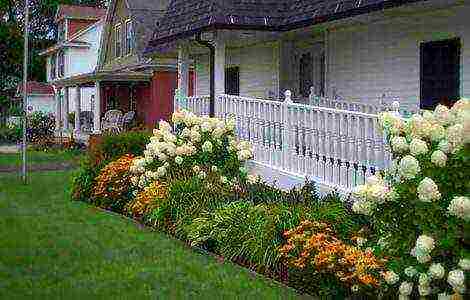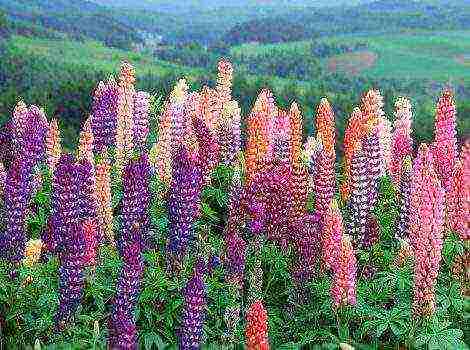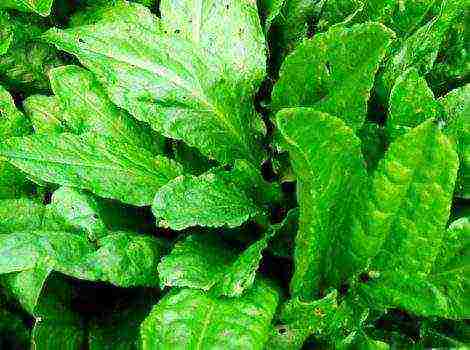Content
- 1 How to plant onions in the spring so that there are large bulbs
- 2 When and how to plant onion sets on the head in open ground to get a good harvest
- 3 How to plant onion sets on greens at home
- 4 When can you plant onions in open ground according to the lunar calendar
- 5 Growing and caring for onion sets in Siberia
- 6 Planting and feeding onions in the open field
- 7 When to plant sevok in the Leningrad region and in the Moscow region
- 8 Proper planting and caring for onions in the Urals
- 9 What should be the soil for growing onions
Good afternoon friends!
Today I had a lot of guests on my site, and the more pleasant it is to write another article for you.
And I will write about onion sets. Experienced gardeners are easily guided when choosing planting material, they know when and how to plant it on the head in open ground in order to get a good harvest.
But what about beginner gardeners? I am writing this article especially for novice gardeners, I will try to tell you how to plant it correctly in the spring, so that there are large bulbs, how to prepare a garden bed and what are the best varieties to choose for planting.

Before you start planting onions, you need to decide:
- with gustatory qualities (savory, sweet, spicy, sweet and sour, semi-hot)
- by the timing of ripening (early, mid-ripening, mid-late)
- with the purpose of the harvest (for sale, storage, salads)
- by size, color and shape of the bulb
After that, we purchase planting material, on which the quality and quantity of the crop in your beds will depend.
How to plant onions in the spring so that there are large bulbs
Preparing onions before planting in open ground
The best planting material for a large turnip is small bulbs 1.5-2.5 cm in size
Sort the sets by size before planting. We sort out, remove sprouted, dried and damaged bulbs
The purchased planting material, 2-3 days before planting, is warmed up near the heating battery.
Then we prepare a nutrient solution: in 5 liters of water we dilute any liquid fertilizer (I take 1 tbsp. L. "Agricola-Vegeta" and 1 tsp. "Agricola No. 2), stir and dip the seed into it in a cloth bag for 10 hours. ...
We prepare the following solution: 5 liters. water 1 tbsp. l. any drug for the prevention of fungal diseases and stir the bags of bulbs into it for 10 minutes.
The seedlings processed in this way are ready for planting.
Preparing the beds for onion sets
We prepare a bed for planting in the fall.
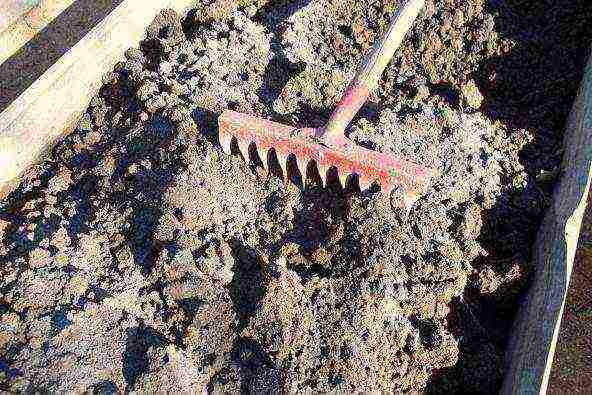
We clean the garden from residues of plant waste and roots, spray with a solution of copper sulfate (1 tbsp. L. Per 10 l of water) at the rate of 1 l per 10 sq. m.
If the soil is acidic, it is necessary to add chalk or dolomite flour (250 g per 1 sq. M.), Pour plenty of water before frost. If the ground is well frozen, there will be less chance of damage to plants by fungal diseases.
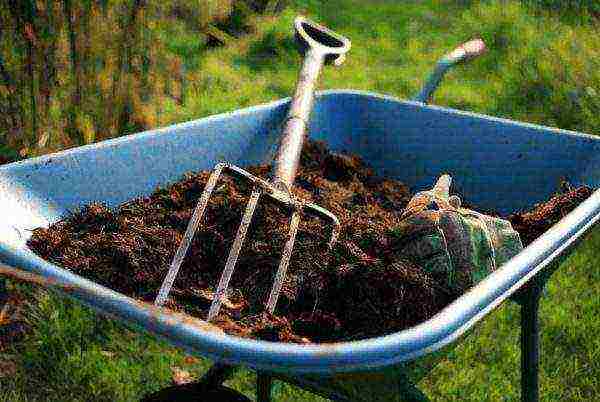
In the spring we apply organic and mineral fertilizers, which and how much depends on the composition of the soil.
Clay soil - 1 sq. m. we add peat - 5 kg, humus - 3 kg, coarse river sand - 3 kg, superphosphate - 1 tbsp. l., any granular fertilizer - 1 tsp.
Loamy soil - 1 sq. m. add peat - 5 kg, humus - 3 kg, superphosphate - 1 tbsp. l., urea - 1 tsp.
Sandy soil - 1 sq. m. we add humus and peat - 1 bucket each, loam or clay - 2 buckets, superphosphate - 2 tbsp. l., any granular fertilizer - 1 tsp.
Peat soil - 1 sq. m. add compost and coarse river sand - 5 kg each, superphosphate and fertilizer in the same proportions as above.
We dig the bed to the depth of the bayonet shovel, equal it with a rake, and compact it. If necessary, we treat it with a warm solution of copper sulfate or potassium permanganate.
We cover the prepared bed with plastic wrap for 2 days.
When and how to plant onion sets on the head in open ground to get a good harvest
Dates of planting seedlings in the spring in open ground
If you plant the onion in cold soil (below 12 degrees), it will go to the arrow. But it is also impossible to be late with landing, because at a higher temperature and a lack of moisture, it will slowly grow.
In the southern regions, sets are planted in the third decade of April, in other regions - in the first decade of May.
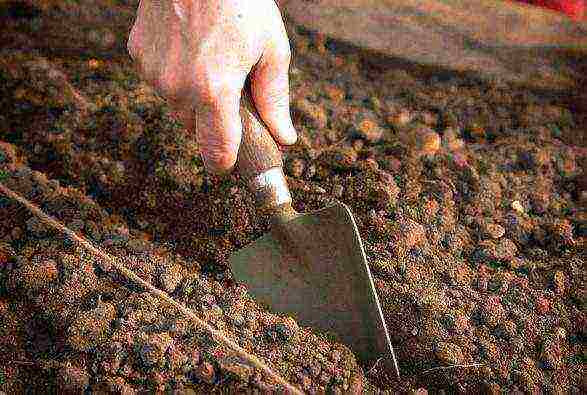
If you are planting several varieties of onion sets, mark the garden before planting. Next, we make grooves for the entire length of the bed 4 cm deep, at a distance of 20 cm from each other.
Water the grooves with warm water (18-20 degrees).
We plant the bulbs at a distance of 8-10 cm from each other.
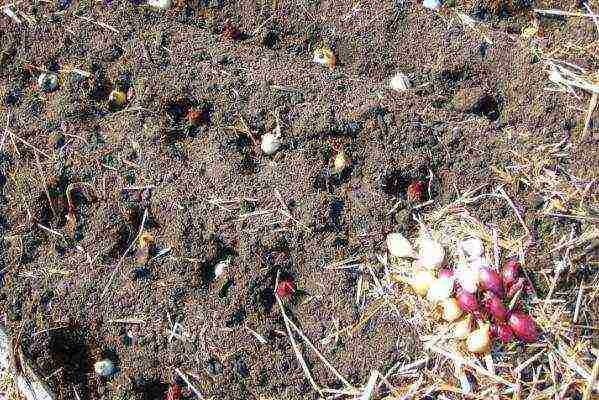
We fall asleep with a layer of soil no more than 2.5 cm above the shoulders of the onions. With less backfill, the seedlings may become bare, and growth will stop, with deeper embedding, ripening will be delayed.
We have fulfilled all the conditions for planting onions on the head, but in order to get a good harvest, we still need to carry out proper care.
Turnip onion care
A hundred times wrong is the one who believes that the planted onion does not require maintenance. If you want to get large bulbs and a rich harvest, get ready for watering, weeding, loosening, feeding and processing.
1. A week after planting, the first shoots appear. The first 2.5 months (May, June and half of July) they need to be watered. We water it with warm water (not lower than 18 degrees) in order to avoid the disease of the plant with downy mildew, and use a watering can so as not to erode the soil and not break the feather.
The calculation of water is given for 1 square meter.
In hot and dry May weather, we will water every week (6-10 liters of water).
In June - every 8-10 days (10-12 liters of water), in July (8-10 liters of water). If the second half of July is hot, water it 1-2 times in 8-10 days at the rate of 5-6 liters.
2. Weeding is done as needed, when the weeds grow by 5 cm, it is easy to remove them. Weeding and loosening are best done in wet soil.
3. During the growing season of the onion, you can do 2-3 additional feeding.
The first feeding is carried out with a weak growth and light color of the leaves: for 10 liters of water - 1 tsp. urea, 2 tbsp. l. organic fertilizer.
The second is 12 days after the first, for 10 liters of water - 1 tbsp. l. fertilizers (Agricola No. 2).
When the bulb grows 5 cm in diameter, we do the third feeding: for 10 liters of water - 2 tbsp. l. "Effekton O", 1 tbsp. l. superphosphate.
4. Prevention against downy mildew is carried out when the feather reaches 15 cm. For 10 liters of water - 1 tsp. copper sulfate, 1 tbsp. l. liquid soap. We spray a feather at the rate of 0.5 liters per 1 sq. m.
or 20 g of "Homa" per 10 liters of water at the rate of 1 liter per 10 square meters. m.
5. As soon as a new young feather stops forming, lodging begins, and the bulbs are well formed, we can assume that the onion is ready for harvesting.
We remove from mid-August to early September. If you are late, then in 8-10 days the onions will grow again and will not be suitable for storage.
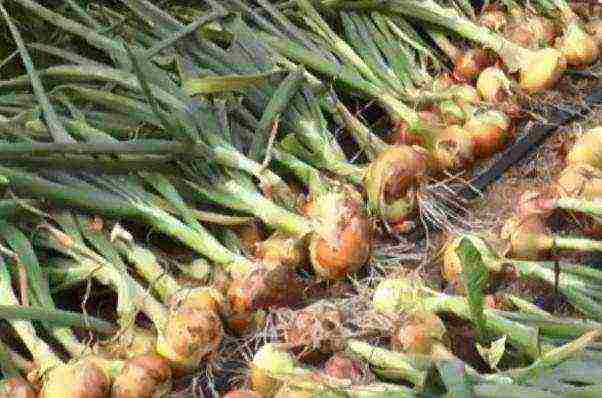
We clean in dry weather. We dig in with a pitchfork, carefully pull it out of the ground and lay it out to dry in the sun for two weeks.
Cut off the feather, leaving a neck 4 cm long. Store in boxes in a dry place.
How to plant onion sets on greens at home
The most popular varieties of onions for planting: Red Baron, Stuttgarten Riesen, Sturon, Corrado, Carmen, Setton, Hercules, Stardust, Golden Semko, Exhibishen.
That's all for now. Dear gardeners, I wish you to grow a rich harvest of onions from seven ailments.
Author of the publication
0 Comments: 407Publications: 146Registration: 04-09-2015
Onions are one of the most common cultivated plants. Many nations use this healthy vegetable in their dishes. And our summer cottages cannot be imagined without an onion garden. The most common planting with onion sets, this method allows you to get a good harvest in one season. Knowing some aspects of planting onions and the rules for caring for them by the fall, you can get this vegetable in abundance.
Preparing onion sets
Small onions 1 or 1.5 cm in size are suitable for growing.The selected planting material must be firm, free of mold and green growth. Softness and other signs indicate a violation of storage conditions. Many growers do not manage to get a harvest due to the early shooting of the bulb; this can be avoided if the seedlings are kept near the heater for two days before planting. If there is no time, the set is immersed in hot water (approximately 45-50 ° C) for 15-20 minutes, then transferred to a container from cold until it cools completely. This method helps to awaken the kidney, after which it will actively begin to grow.
Preparing onion sets for planting in spring includes keeping the bulbs in a disinfectant solution. For its preparation, you can use copper sulfate or manganese. With this treatment, the most common fungal infections are prevented.
When to plant onion sets in open ground
Onion sets are planted at the end of April or in the first half of May. It is important to ensure that by that time the earth has had time to warm up to 13 degrees. Experts do not recommend delaying planting too much because it negatively affects the development of plants and the quality of the crop.
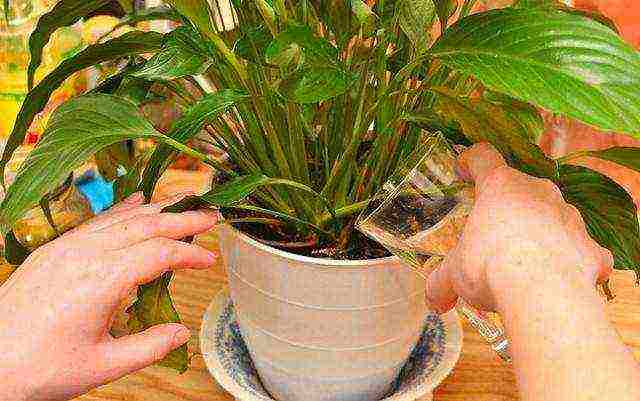 A remedy from which plants grow by leaps and bounds! Just water your plants with it ...
A remedy from which plants grow by leaps and bounds! Just water your plants with it ...
Recommended onion varieties for planting:
- Odintsovets (round-flat shape, weight over 80 grams);
- Bessonovsky (spicy taste, round-flat shape, weight 45 gr.);
- Danilovsky (weight 150-155 g, has excellent taste);
- Ermak (head weight 100g, early ripening, has a semi-sharp taste);
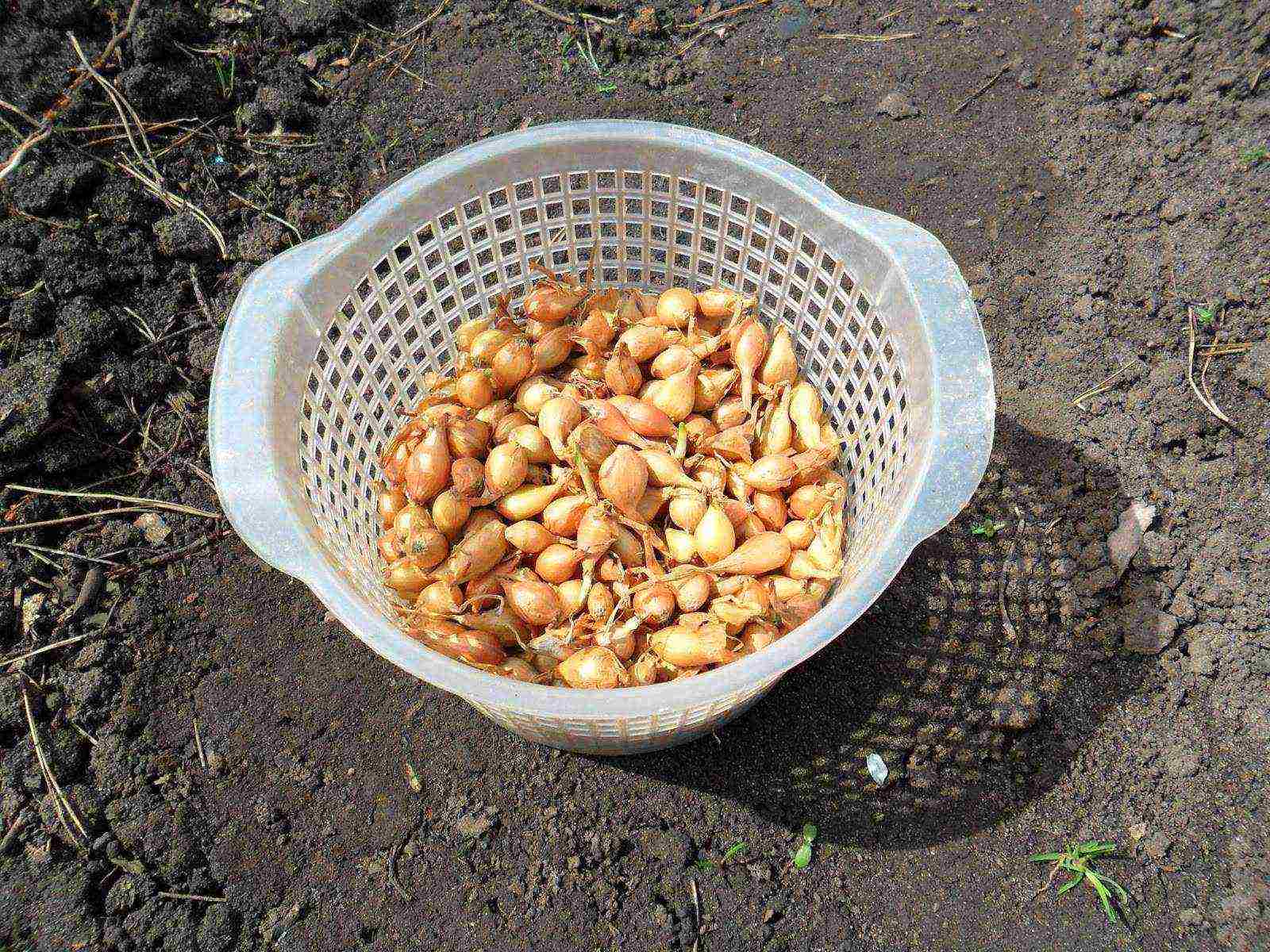
Crops after which you can plant onions
Plant health and, of course, the harvest largely depend on the crop rotation at the summer cottage. Therefore, the planting sites for certain crops alternate. This helps to avoid a deficiency of any nutrients in the soil, to protect it from pests and various diseases.
Favorable predecessors:
- Potato;
- Cabbage;
- Legumes;
- Tomatoes;
- Siderata (oats, buckwheat, vetch, mustard, oilseed radish).
On the beds after onions, garlic, carrots and cucumbers, onion sets are not planted from 3-5 years.
Site selection and soil preparation
Onions prefer to grow in well-lit and dry places, with no near-passing groundwater. The earth should be rich in organic matter, while the pH should correspond to a ph rate of 6.4 to 7.9. In the case of soil acidification, dolomite flour, chalk, lime or wood ash are added. When preparing the beds, rotted manure or compost is added during digging. But this is better done in the fall, since immediately before planting, adding fertilizer to the soil contributes to the development of the green feather, and not the bulb itself. You can limit the flow of pests with the help of spruce branches, which protected young seedlings in winter. To do this, it is shaken over the beds in which the onions will be planted, then the soil is loosened with a rake and watered.
How to plant onion sets in open ground
On the prepared bed, using a rake or other tool, grooves are made 7-9 cm deep and, leaving a distance of about 10 cm between them.The rows are kept from each other at a distance of 30 cm.This method saves space, and nutrients will flow directly to the roots sevka. Before planting, the dried tail is cut off from each bulb (the place where the green feathers were). This procedure is done with sharp scissors very carefully so as not to damage the sprout. In large-scale industries, pruning is not done, but it should be noted in a particular example that onions with a cut-off upper part germinate faster, they are larger and ripen earlier. When planting their bulbs, they are lightly pressed, then covered with soil by 2 cm and watered. A more exact time when to plant onion sets in open ground in 2016 can be viewed in a special gardener's calendar.

Onion sets: growing and care
After the onion sets are planted in open ground, the first shoots will appear in 7 days. Like any culture, onions need weeding, loosening, feeding and watering. In case of dry weather, the onion is watered every other day and the row spacings are loosened. During the growth of the seedlings, the soil should not be dry, but stagnation of water in the garden bed is also unacceptable, as this can lead to rotting of the bulb. By the color of the feather, it is easy to determine whether the plant has enough water. So a bluish-white tint indicates a lack of moisture, and with an excess of it, the greens turn pale. From July, the main varieties begin to ripen the bulbs, in connection with which watering is reduced.
Onion sets are fed twice a season. The solution is prepared at the rate of one glass of organic fertilizer (mullein, urea, or bird droppings) per 10 liters of water. Or you can use a ready-made complex fertilizer after reading the instructions for use. The last feeding is carried out no later than the first half of June. During the period when the planting is not fertilized around the bulbs, you can sprinkle with wood ash.
So that after watering a crust does not form on the ground, loosening is carried out in the aisles.
Protection of onion sets from pests and diseases
In the practice of gardeners, treatment against fungal infections is the norm. It is produced as soon as the feather reaches 16 cm in length. To do this, a teaspoon of copper sulfate is diluted in a 10 liter bucket with the addition of a tablespoon of crushed laundry soap.
Against the onion fly larvae, a mixture made from tobacco, slaked lime and wood ash, added to peat, is used. The resulting product is sprinkled between the rows.
The so-called mixed planting can become a natural protection of onions from diseases and pests. Carrots, marigolds, calendula, lettuce, beets can be planted as neighboring plants in the onion garden. For example, carrots are excellent at repelling the onion fly, protecting the onion sets. Planting and caring in the open field together with herbs and vegetables is good for onions and looks very beautiful.
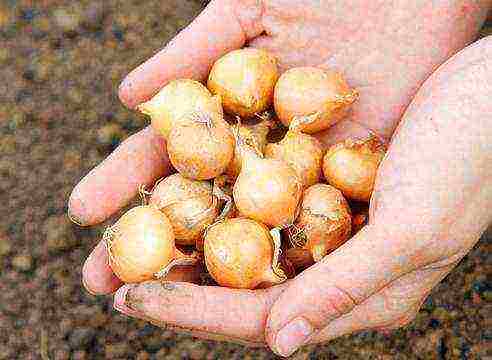
Onion harvesting conditions
Correct and timely care for onion sets in the open field can please with an excellent harvest. Ripe heads are collected in August or early September. The readiness of plants can be determined by firing arrows with seeds, and after the foliage has died, you can start harvesting. The golden color of the husks of the bulbs, which are clearly visible above the soil, also indicates readiness. Onions are harvested in sunny, dry weather, leaving them to dry well for several hours. If, according to weather forecasts, rain is expected in the coming weeks, and the bulbs are not ready for harvesting by external signs, then you can shake off the earth from them or cut the root. This method allows you to accelerate aging by 7 days. Further, the roots are cut off, and storage is continued indoors, placing the onions in one layer. After about 2-3 weeks, the onion crop will be ready for long-term storage.
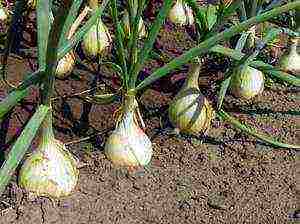 Onions are popular vegetable crops. It is added to salads, soups, meat and fish dishes. Therefore, in almost every summer cottage and personal plot you can see beds with plantings this vegetable. But to get a good harvest, you need to know how to properly plant and care for onions.
Onions are popular vegetable crops. It is added to salads, soups, meat and fish dishes. Therefore, in almost every summer cottage and personal plot you can see beds with plantings this vegetable. But to get a good harvest, you need to know how to properly plant and care for onions.
Planting onions
The crop can be grown in three ways:
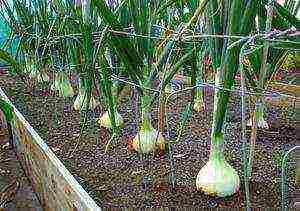 From seeds in one year... This method of growing vegetables is suitable for areas with a warm climate.
From seeds in one year... This method of growing vegetables is suitable for areas with a warm climate.- From seed in two years... In a two-year culture, the plant is grown in areas with short summers.
- Seedling method... This method is suitable for sweet and semi-spicy varieties of vegetables.
But before you start planting onions in open ground, you should prepare a site for it. The beds are recommended to be made in organic-rich, dry, sunny, open areas with neutral soil. If the soil is acidic, then it is preliminarily lime.
You can plant onions after tomatoes, green manure, peas, beans, cabbage crops, potatoes. After other types of onions, cucumbers, carrots and garlic, onions can be planted only after three years.
When planting in spring seed soil for planting is prepared in autumn:
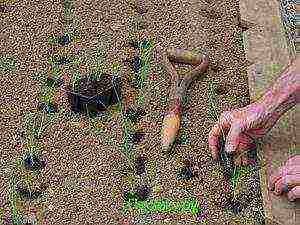 Rotted manure or humus is added to the soil, and the bed is dug to a depth of fifteen to twenty centimeters. It is not recommended to add fresh manure, otherwise only greens will grow.
Rotted manure or humus is added to the soil, and the bed is dug to a depth of fifteen to twenty centimeters. It is not recommended to add fresh manure, otherwise only greens will grow.- The acidic soil is mixed with limestone, ground chalk, wood ash or dolomite flour.
- In the spring, before sowing seeds or planting seedlings, mineral fertilizers are introduced into the soil - potassium chloride, urea, superphosphate.
Growing onions from seeds
 Semi-sweet and sweet varieties in warm climates can be grown from seeds in one year. The planting material is pre-processed, for which the seeds are placed in gauze, moistened and kept for swelling for a day.
Semi-sweet and sweet varieties in warm climates can be grown from seeds in one year. The planting material is pre-processed, for which the seeds are placed in gauze, moistened and kept for swelling for a day.
A bed prepared for planting seeds is watered copper sulfate solution (for 10 liters of water - 1 tablespoon), after which seeds are placed into it to a depth of one and a half centimeters. The distance between the rows should be about thirteen centimeters, and between the seeds - one and a half centimeters. Crops are watered with water from a watering can with a shower head and covered with foil.
Crop care consists in timely moistening of the soil and daily airing of the plantings. When the seedlings appear, the shelter is removed. Seedlings must be thinned out so that there is a distance of two to three centimeters between the plants. The plantings are watered, and the soil around them is mulched with humus. This mulch will feed the plants, retain moisture and prevent weeds from growing. Once again, the seedlings must be thinned out three weeks after germination. The distance between them should be at least six to eight centimeters.
Growing seedlings
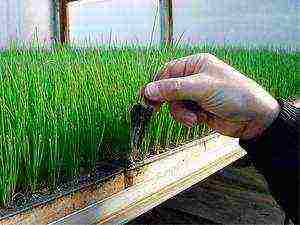 In early or mid-April, pre-treated onion seeds are sown thickly in soil-filled seedbeds. The planting material is placed at a depth of one centimeter, moisten from a spray bottle and cover with foil. After the shoots appear, the shelter is removed. Seedling care consists only in timely soil moisture.
In early or mid-April, pre-treated onion seeds are sown thickly in soil-filled seedbeds. The planting material is placed at a depth of one centimeter, moisten from a spray bottle and cover with foil. After the shoots appear, the shelter is removed. Seedling care consists only in timely soil moisture.
In open ground, seedlings are planted at the age of fifty to sixty days. Before planting in the garden, the roots on the onions are recommended to be shortened by one third of the length.
Planting sevka
In regions with a short summer, in the first year, onion sets are grown on the beds, which are stored at home in winter and planted in the next spring on the beds for growing. Before planting, the onions must be sorted out, warmed up for seven days in the sun and held for ten minutes in a solution of copper sulfate.
Sevok is planted in the beds in May according to the following scheme:
- The distance between the rows should be thirty centimeters.
- The distance between the onions is from eight to ten centimeters.
- Sevok should be planted to a depth of five centimeters.
When growing sets in the fall, you can get turnips, and in the summer - greens. For this, the distance between the landings is five centimeters. During the summer, the onions are torn out through one and used as greenery.
Planting onions in the fall
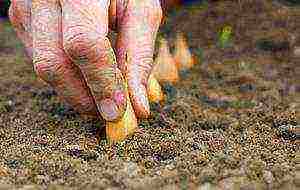 To get the harvest already in July, the seed should be planted in the beds from the fifth to the twentieth of October. Before winter, only cold-resistant vegetable varieties are planted, which include variety Stuttgarten, Strigunovsky, Danilovksky and Arzamas varieties.
To get the harvest already in July, the seed should be planted in the beds from the fifth to the twentieth of October. Before winter, only cold-resistant vegetable varieties are planted, which include variety Stuttgarten, Strigunovsky, Danilovksky and Arzamas varieties.
A bed for winter plantings should be done in sunny, elevated areas. Snow should melt on them before everyone else and water should not stagnate.
The soil for planting the sevka should still be warm. However, before frost, onions should not be planted, since the sevok can dry out.
The planting material is pre-sorted out and warmed up. Sevok is placed in the ground to a depth of five centimeters, in seven centimeters increments.The distance between the rows is about fifteen centimeters. The beds are covered with straw or spruce branches. As soon as the snow begins to melt in the spring, the shelter is removed.
Autumn planting sevka has its advantages:
- After harvesting, another crop can be planted on the garden bed.
- The onion fly is not afraid of autumn plantings, since they have time to get stronger by its appearance.
- At home, the sevok dries quickly and is difficult to preserve until spring.
Onion care
 When growing onions in open ground, it should be provided with timely watering, dressing and treatments from pests and diseases.
When growing onions in open ground, it should be provided with timely watering, dressing and treatments from pests and diseases.
Onions should be watered once a week, using five to ten liters of water per square meter of planting. However, if it rains regularly in summer, then watering may not be necessary. Otherwise, in waterlogged soil, the onions will begin to rot. Learn about the condition of the soil can be green. If it becomes pale, then there is an excess of moisture in the soil. The bluish-white feathers indicate that the soil is dry. In July, the bulbs begin to ripen and watering is reduced.
When growing onions during the season, three additional fertilizing with organic fertilizers are carried out. You can use a solution of mullein, urea or bird droppings for this (for 10 liters of water - one glass of organic matter). One square meter of the garden bed is watered with three liters of solution. The first feeding is carried out after the greens appear. Two weeks later, the plantings are fertilized a second time. The third time, the plants are fed when the onions are about the size of a walnut.
When the greens of the onions reach a size of about fifteen centimeters, it is recommended to treat the plants with copper sulfate, which is good protection against many fungal diseases... To do this, the feathers are sprayed with a solution prepared from ten liters of water and a teaspoon of the drug.
Harvesting and storing onions
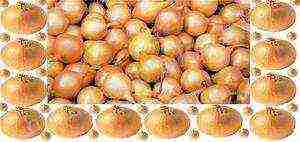 From about mid-August, when the bulbs grow to the required volume, the feathers lodge and new leaves stop forming, you can start harvesting. This should be done in warm, dry weather. If you skip the onion harvesting time, then it may start to grow again... These vegetables are not stored for a long time.
From about mid-August, when the bulbs grow to the required volume, the feathers lodge and new leaves stop forming, you can start harvesting. This should be done in warm, dry weather. If you skip the onion harvesting time, then it may start to grow again... These vegetables are not stored for a long time.
The collected bulbs are evenly laid out on the garden bed. When the onions are dry, they are freed from the ground and additionally dried in a dry room or in the sun. Dried vegetables should be examined carefully. The husked and spoiled bulbs are not suitable for long-term storage. Before you put vegetables for storage, you need to cut off the leaves. Only a neck about six centimeters long should remain. To increase the shelf life of the bulbs, the roots are cauterized.
It is recommended to store onion heads in a dry room with an air temperature slightly above 0 degrees. Since air must flow to the bulbs, they are stacked in stockings, baskets, nets or boxes. During storage, vegetables are regularly sorted out, removing bulbs that have begun to grow or rot.
You can store the crop in the apartment. In this case, you do not need to trim dry leaves on the plant. The container with vegetables is placed away from the batteries. The optimum air temperature should be from +18 to +20 degrees.
It is not recommended to store it along with other vegetables that need high humidity.
Onion pests and diseases
When growing onions in open ground, the following pests are most dangerous for the plant:
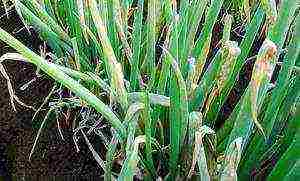 Onion moth. To prevent the appearance of these pests, weeds should be removed in a timely manner, crop rotation, agricultural technology should be observed and plant residues should be destroyed.
Onion moth. To prevent the appearance of these pests, weeds should be removed in a timely manner, crop rotation, agricultural technology should be observed and plant residues should be destroyed.- Onion fly. To prevent this pest from settling on onions, the vegetable is recommended plant in the same bed with carrots, the smell of which the onion fly is afraid.
- Tobacco thrips. Pests are destroyed by Karbofos or Aktellik.
- Caterpillars of the scoop. You can get rid of the caterpillars by treating the plantings with a solution of Gomelin or Bitoxibacillin.
Unfavorable growing conditions and mistakes in care can lead to damage to the onion with various diseases:
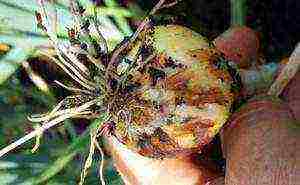 Fusarium is a disease that often appears on plants affected by onion flies. With fusarium, tissues die off at the bottom of the onions, and rot appears, after which the tips of the greens turn yellow. To avoid the appearance of this disease, the set is warmed up before planting at a temperature of forty degrees for ten hours.
Fusarium is a disease that often appears on plants affected by onion flies. With fusarium, tissues die off at the bottom of the onions, and rot appears, after which the tips of the greens turn yellow. To avoid the appearance of this disease, the set is warmed up before planting at a temperature of forty degrees for ten hours.- Downy mildew - the disease can be recognized by a gray bloom on the leaves. Affected vegetables do not form seeds and do not store well. To avoid the appearance of powdery mildew, the sets are warmed up before planting. It is also necessary to ensure that the plantings are not thickened.
- Gray rot - the disease occurs in rainy and damp weather. Diseased plants must be removed. For the purpose of prevention, the planting material is treated with a solution of copper sulfate.
- White rot - acidic soil and excess nitrogen in the soil contribute to the appearance of the disease. Therefore, before planting vegetables, the acidic soil is limed, and fresh manure is not used to feed the onions. Diseased plants should be removed.
- Mosaic is a viral disease in which the plant lags behind in growth, the seeds are almost not formed, the inflorescences become small, and the leaves turn yellow. Affected instances must be removed.
- Neck rot is a disease that can only be detected after harvest. It manifests itself as mold on the outer scales of the bulbs. Neck rot develops under unfavorable conditions for growing plants. To avoid its appearance, the seedlings before planting and the harvested bulbs are warmed up at a temperature of forty-five degrees. Most often, late varieties are affected by this disease.
Viral diseases of the plant are not cured, therefore, preventive measures must be used. To do this, it is recommended to observe crop rotation, not to make thickened plantings, regularly remove weeds and follow all agricultural techniques. Before planting, the onion sets can be warmed up and treated with copper sulfate.
Fungal diseases can be cured special fungicidal preparations. However, it is not recommended to use them, as the bulbs are capable of accumulating poisons.
Onions are an unpretentious plant that even a novice gardener can grow in his area. The popularity of this vegetable is due to the content of substances useful for the human body in it. Eating onions improves digestion and induces the secretion of gastric juice. In addition, the vegetable has a bactericidal, sedative and diuretic effect.
>
Almost every gardener, both beginner and experienced, grows onions in their area. This is understandable, because this vegetable is present in most of the daily dishes that we are used to eating. It is rich in beneficial trace elements, protects in the flu and cold season. In addition, many people love to eat raw onions and do not see fresh salads without it. And this is the right choice. After all, the benefits of onions for human health have been scientifically proven.
Earlier we discussed how to grow onion seedlings, how to properly grow Exibishen onions and all the secrets and subtleties of growing Leek. Today we will take a closer look at how to grow onions from sets. This method is most familiar to gardeners and is considered one of the easiest.
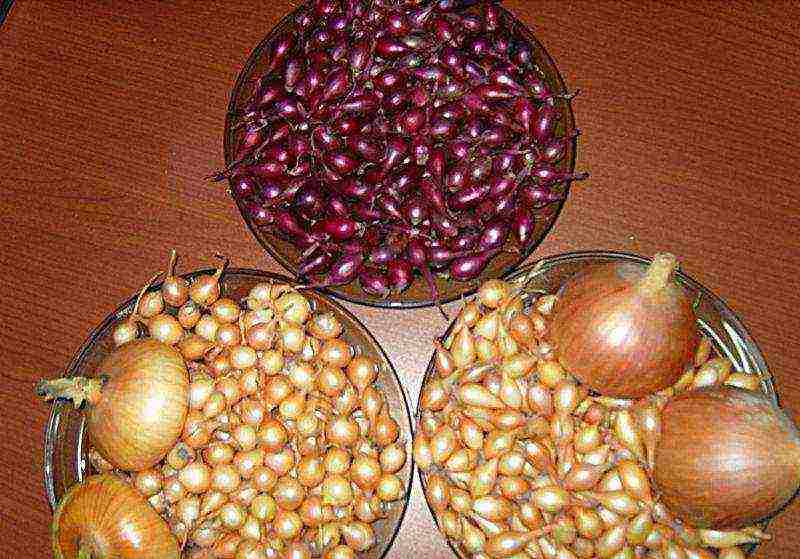
To do this, you need to choose the right variety and buy it. You can also grow sevok from Chernushka yourself. The seeds are sold in stores, you can also get them at home by planting the desired type of onion in the ground and waiting for an arrow with an inflorescence to appear.
When can you plant onions in open ground according to the lunar calendar
For the harvest to be as successful as possible, experienced gardeners recommend adhering to the recommendations of the lunar calendar. Scientists draw up a calendar every year, taking into account the phases of the moon. According to it, we can determine favorable and undesirable days for planting a particular plant.
To determine the landing date, the sevka of the lunar calendar is not enough.Consideration should be given to the location and the surrounding climate. Although onions are not particularly heat-demanding, they grow best in sunny and warm summers.

The most favorable days for sowing onion sets in 2018, based on the region of residence, you can choose from this list:
- April 7, 8, 9, 16, 28;
- May 4, 5, 14, 31;
- June 1, 2, 3, 10, 11, 18.
Onions for the winter can be planted on the following dates:
- September 8, 27, 29;
- October 6, 8, 26;
- November 3, 22, 28, 30.
Growing and caring for onion sets in Siberia
You need to plant onions in Siberia either in the spring or in the fall. It depends on the variety and type of vegetable. For this area, however, spring planting is most suitable. It is better to start sowing seedlings in early May. If you do this in April, when the soil is not yet warmed up enough, the onions will give you only greens; you can forget about large bulbs. If you plant onions in the summer, then the vegetables will not have time to grow to the desired size by the fall.
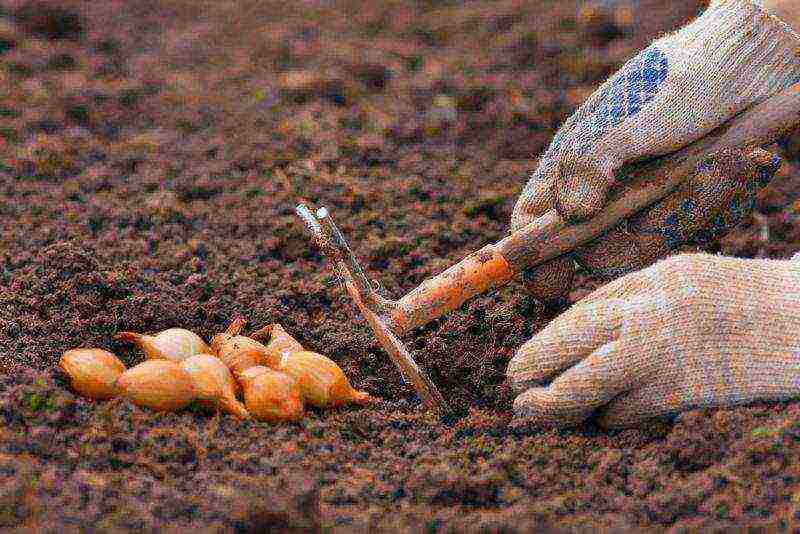
Before planting, sevok, like any other planting material, must be prepared in advance. To do this, dilute 2 tablespoons of table salt in 5 liters of water. Pour the bulbs there for the whole day. Then prepare a pink solution of potassium permanganate and soak the sets there for 2 hours. Immediately after this, you need to start planting in the ground.
Onions love neutral, non-acidic soil. Even in the fall, you need to fertilize the beds with compost or mullein. You need to choose a place that is bright, well-ventilated, away from bushes and trees. Onions are planted in dug and peeled beds at a distance of about 10 centimeters.
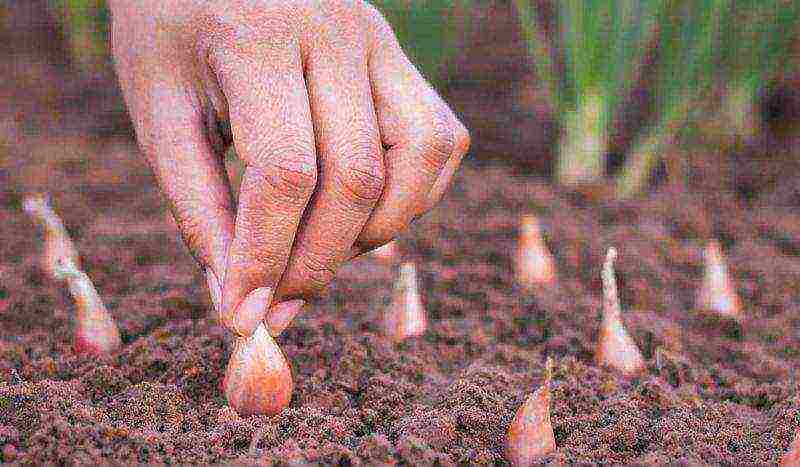
In the first days after planting, onions need constant moisture and loosening. The next two weeks should be watered 2-3 times in 7 days, and then reduce the amount to 1 time per week. Urea and wood ash are well suited for feeding.
If you are aiming to harvest large onions, it is best to avoid organic fertilization.
When the bow is ready to be harvested, you will understand for yourself. The greenery stops forming new feathers, withers and falls off. After harvesting, the onions need to lie on the light, windy side all day until evening.
Planting and feeding onions in the open field
After planting, after about 2 weeks, the beds with onions need to be fed. At this time, the feathers of greenery grow slowly and yellowness is present in them. To help the bulbs begin to grow properly, you need to apply fertilizers with a high nitrogen content. In a bucket of water, dilute 40 g of ammonium nitrate, 30 g of potassium chloride and 50 g of superphosphate. Pour the solution over the beds at the rate of 1.5 liters per square meter.
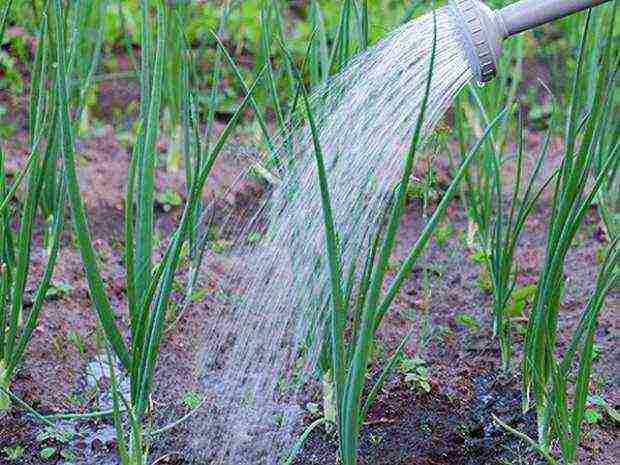
After 2-3 weeks, the beds need to be fed again. In this case, you can use regular compost or mullein. A month later, shortly before digging the onions, apply the last batch of fertilizers. Here potassium and phosphorus will help you. You can independently make top dressing as follows: dissolve 300 g of ash in a bucket of hot water and leave for 2 days. Water at the rate of 2 liters per 1 square meter.
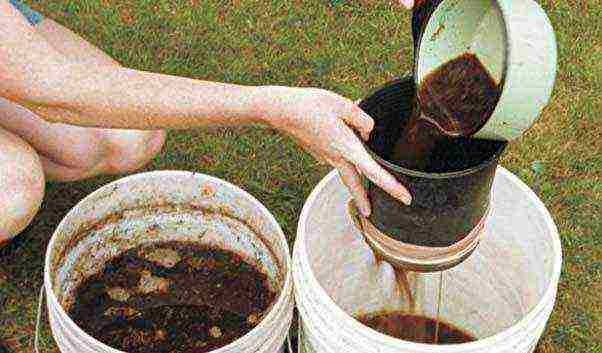
In addition, in specialized stores you can find special fertilizer mixtures that are sufficient to dissolve in water.
When to plant sevok in the Leningrad region and in the Moscow region
In the Moscow region and the Leningrad region, it is necessary to plant sevok in early May, when the earth is sufficiently warmed up. Although onions are not too thermophilic, they bear fruit much faster and better in warm soil.
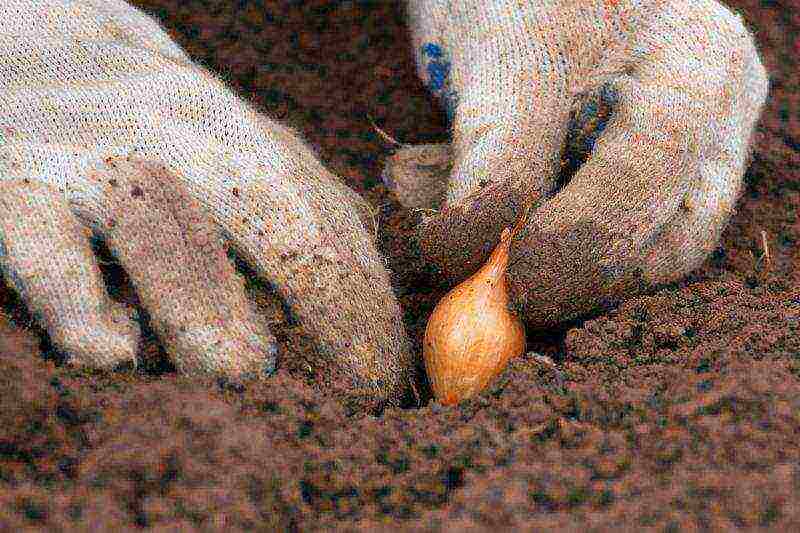
Prepared seeds should be planted in fresh beds, free of weeds and stones. They should be on a well-lit and ventilated side. Excessive shade can provoke onion rot.
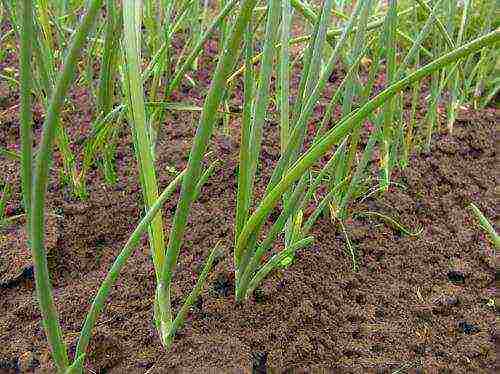
Planting onions early can rob you of strong bulbs, and only lead to dense greenery. Planting onions at the end of June is also a wrong choice. The onion will not have time to properly ripen and reach the size required for storage.
Proper planting and caring for onions in the Urals
You need to sow seedlings in open ground around mid-May. The onions are planted in the beds at a distance of 10 centimeters, pressing them to the top into the ground.Weeding is one of the most important components of proper onion care. Weed removal needs to be done every one and a half to two weeks. Weeds provide the soil with excessive moisture, which can lead to rotting onions.
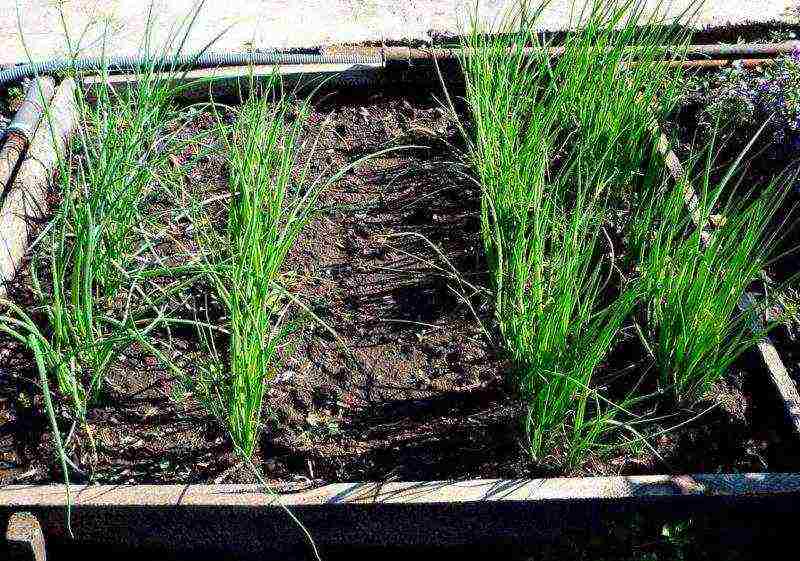
In the first 2 weeks after planting onions in open ground, the soil needs to be watered every 7 days. The water should be cool, about 15 degrees above zero. Water consumption is approximately 13 liters per 1 square meter. After the appearance of green onions, watering should be reduced to 1 time in 2 weeks.
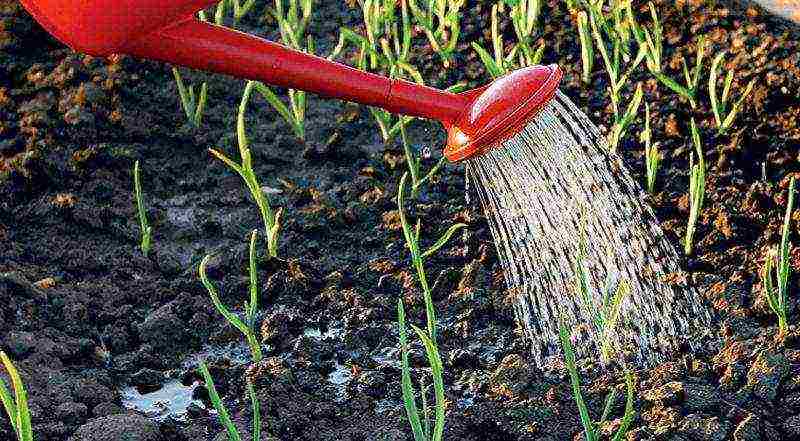
After irrigating the beds, the soil around the bulbs must be loosened to ensure proper access of water and oxygen to the root system. The appearance of the post-irrigation infusion has a bad effect on the quality of the crop.
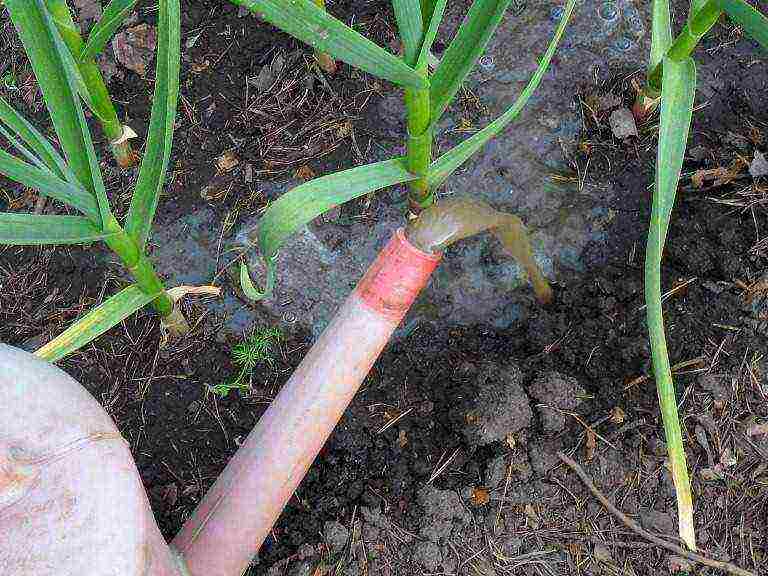
2 weeks after planting, you need to make the first top dressing. Nitrogen fertilizers are perfect for this. 14 days after this, it is the turn of the second feeding. Here, phosphorus and potassium substances are in priority.
3 weeks before the expected digging, watering onions should be stopped.
What should be the soil for growing onions
As we already know, the optimal place for sowing seedlings is a bright, preferably sunny area, without the presence of bushes and trees nearby. The soil should be non-acidic and not prone to large weed growth.
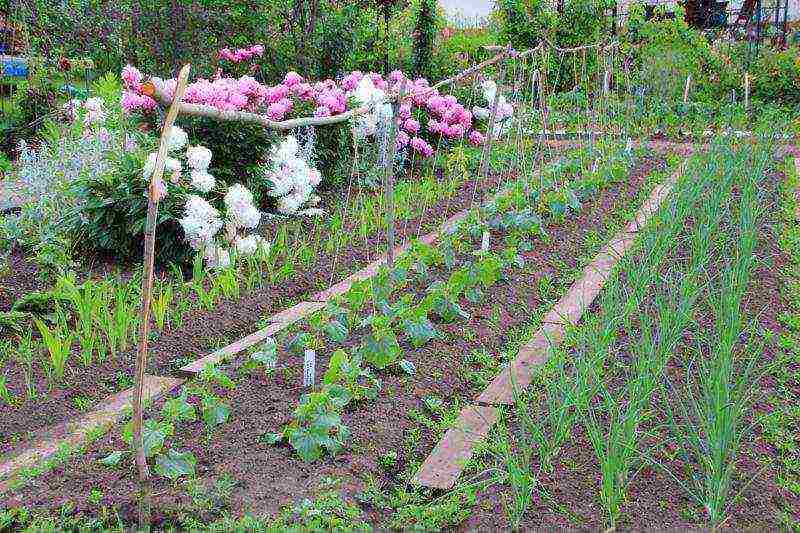
It is great if, before sowing onions, zucchini, cabbage, legumes, potatoes or pumpkin grew in this soil. Typically, these vegetables require organic fertilization, which gives these precursors an advantage.
Onions are glad to be next to cabbage, carrots and beets. Unless, of course, they grow very close, blocking the sunlight with their tops. The distance between the beds should be at least 50 centimeters.
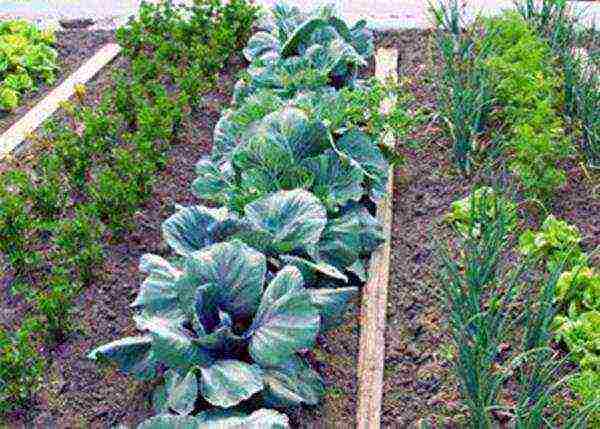
Onions prefer loamy and sandy soil. Too heavy soil will not provide a good harvest.

Now you know how to properly grow onions so that your neighbors look at your harvest with envy. But, perhaps, the most important rule of growing any kind of vegetables is a good mood. After all, fruits and vegetables grown with love are tastier than anything else. So stock up on the right mindset for a bountiful harvest!
Author of the publication
Comments: 1Publications: 35Registration: 02-12-2017
